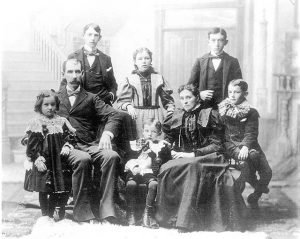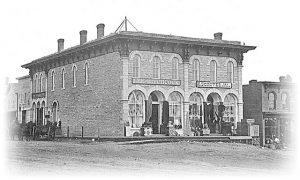Whan that April with his showres soote
The droughte of March hath perced to the roote,
And bathed every veine in swich licour,
Of which vertu engendred is the flowr…
Thanne longen folk to goon on pilgrimages.
Oh, how I loved Chaucer’s Canterbury Tales! So much so that I wrote my master’s thesis on the Wife of Bath’s Tale. Now that April’s showers have pierced the drought of March, are you longing to go on pilgrimages? If so, you are in luck, because the month of April 2016 – and May 2016 – will feature a variety of events celebrating what Carleton College in Northfield is calling “WALK! A festival of walking, art & ideas.” Carleton asked St. Olaf College to walk along with them, so there are collaborative efforts afoot.
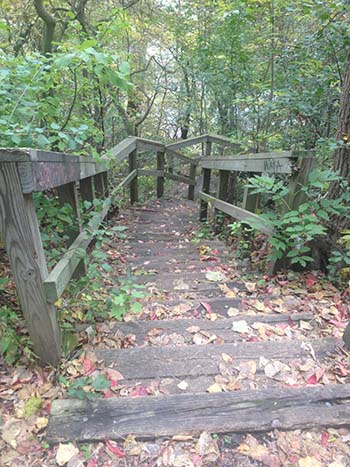
Artist and writer Andy Sturdevant’s feet took him on a 40-mile walk from his home in Minneapolis to Northfield last October, a journey commemorated in Via Northfield, which opened the festival at St. Olaf’s Flaten Art Museum on Feb. 19. When Flaten’s director, Jane Becker Nelson, asked Sturdevant to contribute his artistic vision to the festival, he decided to build on the themes of history, place and walking, which he has explored in Minnesota since relocating in 2005 from Louisville, Kentucky, after getting a BFA degree in painting at the University of Louisville in 2004. He writes a weekly column on neighborhoods, art, history, architecture and visual culture for MinnPost and has had his artistic works exhibited at the Soap Factory and the Minneapolis Institute of Art, as well as in galleries and spaces in Chicago, Philadelphia, New York, Seattle, Austin (TX), Milwaukee, North Carolina and Kentucky. His book, Potluck Supper with Meeting to Follow, was published by Coffee House Press in 2013. Sturdevant had a residency at Carleton College last spring in which he celebrated its Gould Library as an “incubator” for all kinds of creative endeavors.
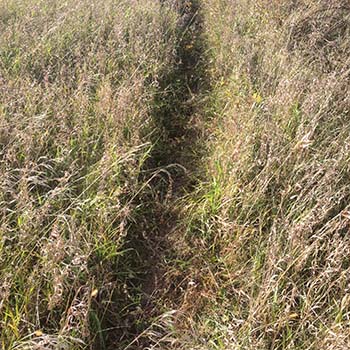
Sturdevant plotted his walk using Google Maps and left Powderhorn Park (three miles south of downtown Minneapolis) at 7:30am on Oct. 9, 2015. The exhibit which resulted displays 15 way stations about an hour’s walk apart, with attractions and amenities available like food, water, first aid, supplies and scenic spots. Historical references, photos and newspaper clippings abound, including his own cell phone photos taken along the way. (One striking photo from the Minnesota Historical Society, “Encampment of Sioux Prisoners at Ft. Snelling,” was taken after the 1862 U.S.-Dakota conflict.) On the walls are pedestrian reports. A dog-walker tells of her experiences and a 4th generation Eagan resident, Martin Diffley (an organic farmer), is quoted about the roads in the ’50s and ’60s. Richard Seurer reports about running gravel roads barefoot for Farmington High’s first cross country team in the fall of 1967 and winning the conference. There are places where museum-goers can fill out walking reports of their own.
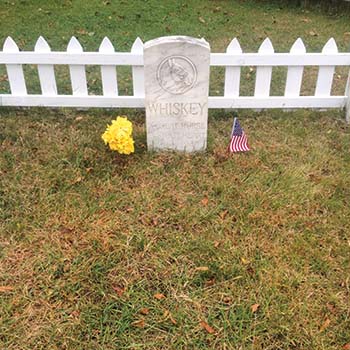
By the time Sturdevant reached Farmington, 12 hours after he started, he had covered nearly half of his walk, taking advantage of the multi-use trail on Pilot Knob Road (one of the oldest in Dakota County) from Mendota Heights to Farmington. After stops for supper at Crooked Pint Ale House in Apple Valley and a drink at The Mug in Farmington, he took a taxi for an overnight stay at a motel in Lakeville, returning the next morning to his route south. He then took unpaved country roads which often parallel and intersect the Dan Patch Railroad Line of the early 20th century.
Sturdevant told me that as he left behind housing developments, strip malls and shopping centers and saw other people only as they passed by in cars, he stood out against the landscape in a very dramatic way. He could now see “all the way to the horizons” with the “undulations in the gentle slope of the hills,” the fields and waves of grass which reminded him of the ocean.

In the portion of Sturdevant’s exhibit labeled “Northfield,” Sturdevant has a Manitou Messenger story, “Wackiest Walkers Wander,” from March 25, 1955, about five Oles who formed a walking club and walked blindfolded from St. Olaf to downtown. The story said, “During the walk, which took a little over an hour, the only interference was from hecklers who gave the boys wrong directions and from the police who wouldn’t let them cross Second Street blindfolded.” A backward walk to Dundas was being planned. I called Wendell (Wendy) Miller, St. Olaf ’55, originally from Canby, Minn., at his winter home in Florida for more details. He led the quintet with Northfield’s Lars Kindem, NHS ’51, St. Olaf ’55. Miller told me, “We felt ourselves to be creative liberal arts students who wanted to do something exciting, inexpensive and offbeat.” He estimated there were 15 students, including both Oles and Carls, who did the trek backwards to Dundas to see who could finish first. Toward the end, some at the head of the pack turned around and started running, unbeknownst to those at the rear, which created a “fracas,” as Miller recalls.
Another Northfield story is of the Carleton men who batted a baseball from Northfield to Metropolitan Stadium to see a Twins game on May 22, 1967, after Carleton was invited to celebrate its centennial there. (Sturdevant had contacted me after hearing about this event, which is in my Historic Happenings at Carleton College book.) Also featured is Sturdevant’s interview with Gene Finger, who walked from Northfield to Fargo in 1980 (see the sidebar for my conversation with Finger). More recently, Carleton students Kathy Dooley, Wren Wells and Bettina Wiesenthal walked for 14-straight hours to the Mall of America in Bloomington (former site of the Met) during spring break of 2013.
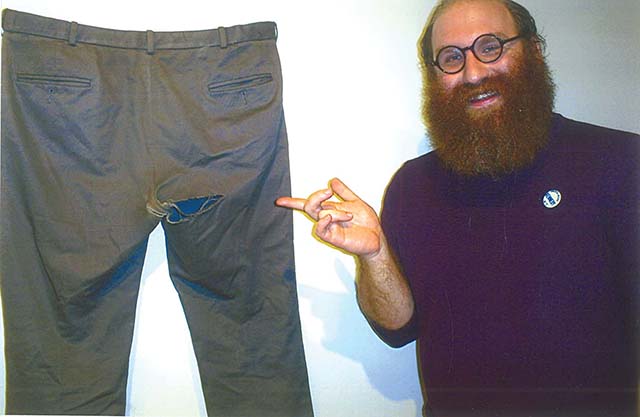
Sturdevant came to his own destination at 3:15pm after a day and a half of walking. If you are inspired to follow Sturdevant’s Via Northfield route, he concludes the exhibit with these words: “St. Olaf students, their hearts filled with faith, hope and charity, will be on hand to assist you upon arriving, should you be thirsty, dazed or disoriented following your journey. Simply ask the nearest student for help.” And he notes that “Buntrock Commons features a number of water fountains.”
Sturdevant will lead a walk to Waterford Township Hall on Saturday, April 16, 2016, starting at Flaten at 11am for the six-mile walk of approximately an hour and a half. There will be musical accompaniment by Mike Gunther and refreshments, followed by a bus back to campus. The Via Northfield exhibit closes on April 17, 2016.
Walking Festival March 31 to May 21 2016
 The walking festival at Carleton’s campus stretches from March 31 through May 21. It was spearheaded by Professor John Schott of Carleton’s cinema and media studies department, who felt that walking could be a spring theme that would draw in many Carleton departments, could be shared in ways at St. Olaf, and would be open to the public.
The walking festival at Carleton’s campus stretches from March 31 through May 21. It was spearheaded by Professor John Schott of Carleton’s cinema and media studies department, who felt that walking could be a spring theme that would draw in many Carleton departments, could be shared in ways at St. Olaf, and would be open to the public.
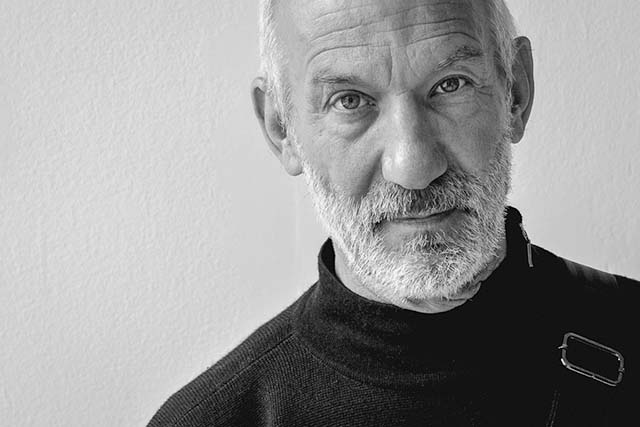
Attention will be paid to “walking artists,” which can be defined as artists who use the simple act of walking to create an artwork of any kind, including performance art and video. Schott told me that there is a long tradition that goes back to the 18th and early 19th century of walkers who were observers of the city and landscape and walking artists in the 1960s and 1970s who “used walking and nature and ways of walking as ways of making art.” Today, Schott said, “People are using GPS and global mapping and all sorts of things to change your awareness of where it is that you walk. And there is a kind of revival of walking art in Europe, in England especially, and in the U.S.”
Carleton’s Ross Elfline, assistant professor of art, will speak on March 31 at noon at Boliou Hall 104 about Walking in Contemporary Art, an overview of classic walking artists, including “situationists” that Elfline described to me as “political rabble-rousers” who walked through cities in France in the 1950s. In the 1960s and early 1970s, Richard Long and Hamish Fulton walked in rural areas and marked the landscape “by altering it by walking repeatedly in certain areas.” Elfline will also focus on the Belgian artist, Francis Alÿs, who lives in Mexico, and his series of seven walks exhibited in London in 2005. In Guards, using closed circuit cameras, Alÿs filmed 64 Coldstream Guards of the British Army walking separately through London and instructed them to fall into formation when they came across one another. Elfline said the use of surveillance cameras shows the theme that if you are walking through the city, “somebody is always watching you.”
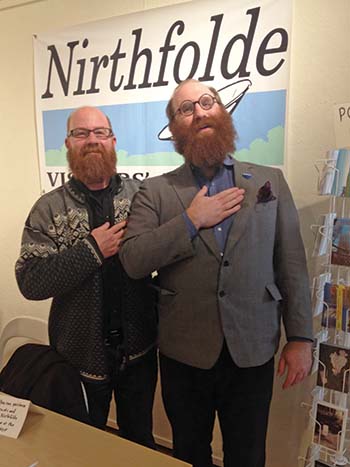
On April 1, the Weitz Center for Creativity will be bursting with creativity. As you enter the Perlman Teaching Museum (located in the atrium on the northeast side of the former Northfield Middle School), you will find a kiosk offering brochures, maps and guides to an alternative universe called Nirthfolde. Carleton art professor David Lefkowitz and web content specialist Doug Bratland dreamed up Nirthfolde for a Northfield Arts Guild exhibit in 2013 and are happy to bring it back by “reconfiguring” a gallery utility closet as the Ambulatory Nirthfolde Information Dispensary. Lefkowitz showed me a map of the Cowling Arboretum Contemplative Transit, in which the trail system in the Arb is reimagined as a subway or public transit system. Here you can find, for example, subway stops like Grand Central Station where paths converge, others named after directors of the Arb (Stewsie and Braker’s Acres), another called Lost Keys and so on. Lefkowitz said other brochures and maps will encourage people to wander around Nirthfolde in a way that also reimagines the space of Northfield, including a self-guided tour of “Monoliths of Mystery.” During the opening, Bratland and Lefkowitz will be on hand to answer questions about (as Lefkowitz put it) the “Nirthfudlian” version of Northfield.
Opening in the Braucher Gallery of Perlman on April 1 is Crossings, a site-specific installation by artists Harriet Bart of Minneapolis and Yu-Wen Wu of Boston, whose last collaboration was in 2015 at St. Paul’s Minnesota Museum of American Art. Their artist statement says, “We walk for the pleasure of wandering and thinking, for exercise, as a communal activity, to reach destinations and, in some circumstances, for survival.” According to a 2015 United Nations report, “The number of people forcibly displaced at the end of 2014 had risen to a staggering 59.5 million” with more increases in sight. To symbolize the immensity of this issue, six tons of river rocks have been brought in and arranged by the artists and student helpers into the suggestion of a pathway. Some rocks are numbered and numbers are also scrolled in a video to underscore this global crisis. The artists ask, “How many steps must these people take to reach a place they can call home?”

Christina Chang, interim director of the Perlman Teaching Museum, told me that visitors are encouraged to take one of the rocks and walk one and 3/4 miles to a satellite site at the Flaten Art Museum at St. Olaf, while thinking about the weight of what refugees might be carrying on their journeys. The rocks will later be recycled for campus use. The artists’ talk and reception will be at 7pm on April 1. Nirthfolde and Crossings run through May 1, while Passages: Walking in Contemporary Art in the Kaemmer Gallery runs through June 10, reopening for the Carleton reunion June 16-19. Passages is an exhibition of artworks on walking, drawn from Carleton College collections, the Walker Art Center Library, national galleries and others.
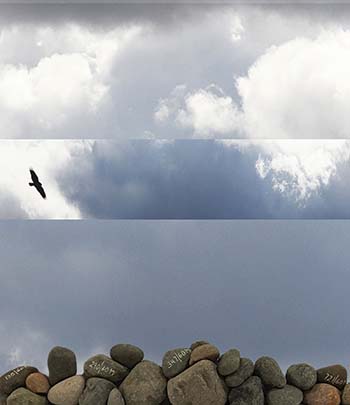
On April 5, there will be a Walking Path Memoir Workshop with Carleton professor of English Susan Jarret-McKinstry, exploring memory and place. Distinguished Asian Scholar and Carleton Professor Emeritus Bardwell Smith will be speaking at noon on April 7 in Weitz 236 on the ancient 900-mile Shikoku Buddhist pilgrimage in Japan, a route he has walked on seven occasions between 1983 and 2002, including twice with 30-40 American students from the Associated Kyoto Program (AKP) founded in 1970 by Carleton and Amherst.
Angela Ellsworth, walking artist-in-residence, will give a presentation There to Here on April 12 and on Peripatetic Histories: A Navigation of Distance, Duration and Topography through Contemporary Art on April 21, both at Weitz Cinema at 4:30pm. Ellsworth, who is a professor and co-founder and artistic director of the Museum of Walking at Arizona State University in Tempe, is inviting everyone to join her in one-hour walks, meeting at the Weitz Center atrium at 9am on April 11, 13, 15, 18 and 20. She will lead another walk on April 23 at 12pm. On April 11, she will also give a talk at St. Olaf’s Dittmann Center 305 at 7pm.
Cecilia Cornejo, visiting assistant professor of cinema and media studies at
Carleton, will give a talk, Wanderer, there is no path. The path is made by walking, on April 27 on the centrality of walking in artistic practice. Urban geographer Bill Lindeke (streets.mn) will speak at noon on April 30 on When in Roam: Sidewalks, Space and Perception in Northfield, followed by a guided walk of Northfield’s sidewalks. On May 2, Mark Heiman, of Carleton’s web services group, will lead a labyrinth walking meditation, an ancient form of spiritual pilgrimage, at 5pm at Carleton’s Skinner Memorial Chapel. Carleton Librarian Emeritus Sam Demas (hut2hut.info) will offer international views on the joys and environmental impacts of walking and differing modes of shelter in his talk, Gimme Shelter! Care and Feeding of Long Distance Walkers, at 4:30pm on May 5 at Weitz Cinema.
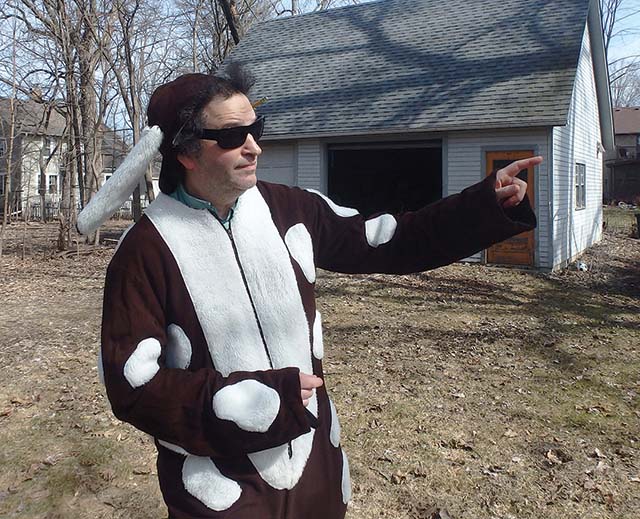
Artist David Lefkowitz will put on a dog costume on May 7 and let his alter ego, Rover Self, conduct three afternoon performance walks, “Self” Guided Canine Tours of Territory Sector 6, called Off-Leash. Thus, a dog will be taking people for walks. Lefkowitz told me that he will be “wandering around the neighborhood,” experiencing space as his own beagle mix dog might, not with property boundaries but territories. Does that mean Rover Self might chase squirrels up trees and sniff around garbage cans? When I asked him that question, Lefkowitz laughed and said he might, because “I want that to be an authentic experience, as authentic as something as artificial as that can be.” He will not be bringing his dog on these walks and asks that you not bring yours.
On May 8, there will be a guided walk on the geology of the Carleton Arboretum led by Carleton senior Forrest Williams (gather at 1pm at Lower Arb entrance on Hwy 3) and a Buddhist Walking Meditation led by Prof. Roger Jackson at 5pm at Skinner Chapel. On May 9, at 7pm in the Weitz Center, the Carleton Film Society presents Walking the Camino: Six Ways to Santiago, the award-winning 2013 documentary following six people walking in Spain.
May 10 features Roundtable: Pilgrims and Pilgrimages, a discussion with visiting scholars Prof. Katherine Beebe of the Univ. of Texas at Arlington, Prof. Nanette Hanks of the Univ. of Minn. and visiting walking artist-in-residence Phil Smith at 12pm at Leighton Hall. Smith is the leading English writer on and practitioner of walking art. On May 11, there is a dance performance called Walk the Weitz where dancers and viewers will “walk” not just the floors but walls, ceilings, everywhere starting at 7pm at the Weitz Center for Creativity. Jane Shockley, senior lecturer in dance at Carleton, will guide this “somatic walking experience.” Phil Smith will talk on The Rough Arts of Contemporary Walking, the autobiographical account of his pedestrian journeys, on May 12 and on Walking Beyond Romantic Fusion: Differences in Exploratory Walking on May 17, both at 4:30pm at Weitz Cinema. An off-trail exploration in the Arboretum will be led by Nancy Braker, Arb director, on May 18 (meet at 6:30pm at the Arb kisok in front of the Recreation Center).
Carleton professor Linda Rossi and St. Olaf professor Meg Ojala are sharing an assignment in their photography courses. Their students will be walking with a naturalist through Caron Park, a remnant of the Big Woods, and will work together doing the shooting, critiques and printing of photos to create a joint exhibition of visual arts, which opens at the Weitz Center on May 12.
On May 21, shedding his dog costume, David Lefkowitz will present Amble: Peripatetic Gallery Wandering. This is his “gallery on wheels” that he developed as a project at the 2013 Northern Spark Festival in St. Paul. Look for him to be pushing his “fully operational non-commercial art space” all day, all over town.
And remember, in the words of Steven Wright, “Everywhere is walking distance if you have time.”
Gene Finger Remembers 300-Mile Walk to Fargo in 1980

Gene Finger’s feet took him 300 miles to the Sertoma convention in Fargo as a fund-raiser in the spring of 1980 when he was about to turn 50. I interviewed Finger not long after the Feb. 19 opening of Andy Sturdevant’s Via Northfield at St. Olaf’s Flaten Art Museum in which Finger’s feat is acknowledged.
Finger told me that his April 12-24 walk was inspired by the death of John Johnson, his business partner and the one who had introduced him to Sertoma, whose national mission is to aid hearing loss. In 1976, Johnson had been hit by a truck while at a convention in Lancaster, Pa., and as a memorial to him, Finger decided to ask for pledges per mile for his proposed walk. Pledges ranged from ten cents to $5 a mile.

Finger, who said he was not normally athletic, thought he was ready after practice walks of five to seven miles a day and one of 17 miles. Finger said his banker told him “this was the absolute most foolish thing that he had ever heard of,” but Finger’s doctor said he could walk as far as he wanted to – but he should not run, because of his bad back.
According to a Northfield News account from April 17, 1980, Finger’s walk “started with a bang” at 7am on April 12, with a send-off “compliments of Wayne Eddy’s six-shooting.” Signs urged him on: “Our hearts are with you, but we’re leaving our feet behind” and “Good Luck Gene. We’re behind you all the way.”
Finger headed north on Cedar Avenue, stopping for lunch at a restaurant in Apple Valley. Finger told me he promptly drank three glasses of ice water. Then, he “took one bite of the meal and passed out.” He came to rapidly, but thought, “What a way to start!” After that, he would order water and orange juice with no ice at his stops.
A Sertoman from Minneapolis had donated a support vehicle (driven by others who traded off) in which Finger could spend the night along the way. Finger made it to Bloomington that first day, then walked across Minneapolis to Anoka. Finger said that when he came to the first cross street in Anoka, he could not lift his leg onto a curb “because it was locked into a certain cadence. I had to reach down, grab my trousers and pull my leg up.”
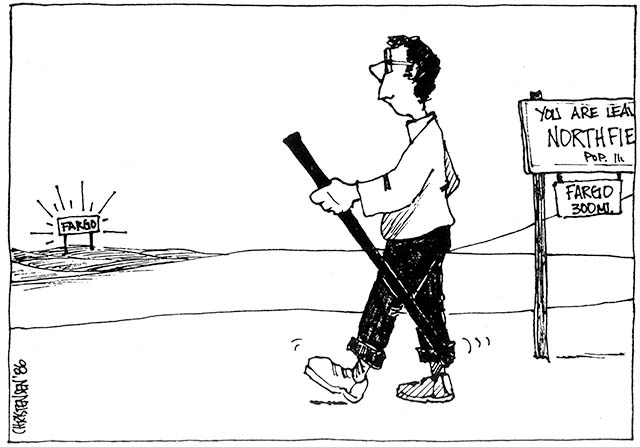
Finger said the worst couple days of walking for him happened after he left Ashby and headed to Fergus Falls on a day the temperature hit 101 degrees. When a reporter came out on his route to talk to him, Finger found he could not make a sound until he recuperated at a truck stop. The next day, despite a drop of 40 degrees in temperature, he walked into a strong wind, which wore him out so that “I would have to stop every couple three miles and just lay down in the ditch and rest.” Finger said he would walk four mph in the morning and slow up in afternoon. Then he had to establish goals: make it to that hill up ahead, then from one telephone pole to another, then to the next crack in the road. “By making small goals, I was able to complete the larger one for the day.” Finger often walked 25 miles a day, which he now thinks was too ambitious. Once he even went a half-mile out of his way when he saw a sign for a café that specialized in pies. He had a slice of sour cream raisin, “my favorite.”
Upon Finger’s arrival in Fargo, the Sertomans took him out to a Mexican restaurant for lunch and he remembers there were pitchers of margaritas to celebrate. That night he got an ovation at the convention and the Sertoma Foundation ended up with a check for more than $20,000.
Was there any one thought that had kept him going? Yes, Finger told me. For many miles he “mulled over” the idea that “no matter what happens today, the sun is going to come up tomorrow morning.”
![]()


